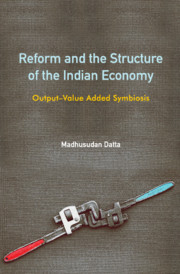Book contents
- Frontmatter
- Dedication
- Contents
- Tables
- Figures and Box
- Preface
- 1 Introduction: The Take-off
- 2 Growth and Structural Change since 1978–79: Issues in Measurement
- 3 Sectoral Shares in Indian GDP: How to Regard It?
- 4 Sectoral Growth: GVA–Output Dichotomy
- 5 Manufacturing Sector in the Indian Economy: Paradox of Growth and Stagnation
- 6 Growth and Sectoral GVA Adjustments
- 7 Demand for Intermediate Services
- 8 Linkages and Key Sectors in the Indian Economy
- 9 Conclusion: A Perspective of Indian Economic Growth
- References
- Index
7 - Demand for Intermediate Services
Published online by Cambridge University Press: 17 March 2020
- Frontmatter
- Dedication
- Contents
- Tables
- Figures and Box
- Preface
- 1 Introduction: The Take-off
- 2 Growth and Structural Change since 1978–79: Issues in Measurement
- 3 Sectoral Shares in Indian GDP: How to Regard It?
- 4 Sectoral Growth: GVA–Output Dichotomy
- 5 Manufacturing Sector in the Indian Economy: Paradox of Growth and Stagnation
- 6 Growth and Sectoral GVA Adjustments
- 7 Demand for Intermediate Services
- 8 Linkages and Key Sectors in the Indian Economy
- 9 Conclusion: A Perspective of Indian Economic Growth
- References
- Index
Summary
Observation and description, definition and classification are the preparatory activities. But what we desire to reach thereby is a knowledge of the interdependence of economic phenomena.… Induction and deduction are both needed for scientific thought as the left and right foot are both needed for walking.
—Quoted from Economic Generalizations Or Laws (Marshall, 1961: 24)Introduction
Input–output transactions tables (IOTTs) provide a very convenient tool to understand an economy's sectoral interconnections. It provides both the production and the expenditure sides of the economy in a compact form and is a very practical way of presenting national accounts that must show a balance between the two sides for conceptual accuracy. We had a glimpse of the importance of this balance for economic analysis in the previous chapters and we will continue to exploit the interindustry relations in the rest of the book. However, since our experience concerns a multidimensional reality, capturing it in single or in two dimensions inevitably means a constrained view; but that serves to show how constrained we are.
What readily comes to mind is adding a time dimension to the two dimensional picture presented by the IOTTs. Just as a three dimensional object is sought to be understood by taking multiple slices – what can be thought of as two dimensional – of the object, we seek to understand an economy over time using multiple IOTTs at, more or less, regular intervals of time. While an IOTT may be viewed as a snapshot of the economy, it really represents an interval – a year, collapsed to a single point. In computing the input (or technical) coefficients we divide the specific input required to obtain a quantity of output over a year, by the output quantity. Thus we compute the average, and in this sense, representative coefficient for the year. One seeks to visualize a rule that explains movement from one observation to the next. Since reality is extremely complex, specification of a simple rule seems silly but its utility lies in generating an insight. In a simple dynamic analysis one may add a time dimension with a rule in the form of a fixed parameter, say, a uniform rate of growth of a variable per year to see its impact on some other variable under focus.
- Type
- Chapter
- Information
- Reform and the Structure of the Indian EconomyOutput-Value Added Symbiosis, pp. 123 - 139Publisher: Cambridge University PressPrint publication year: 2020



